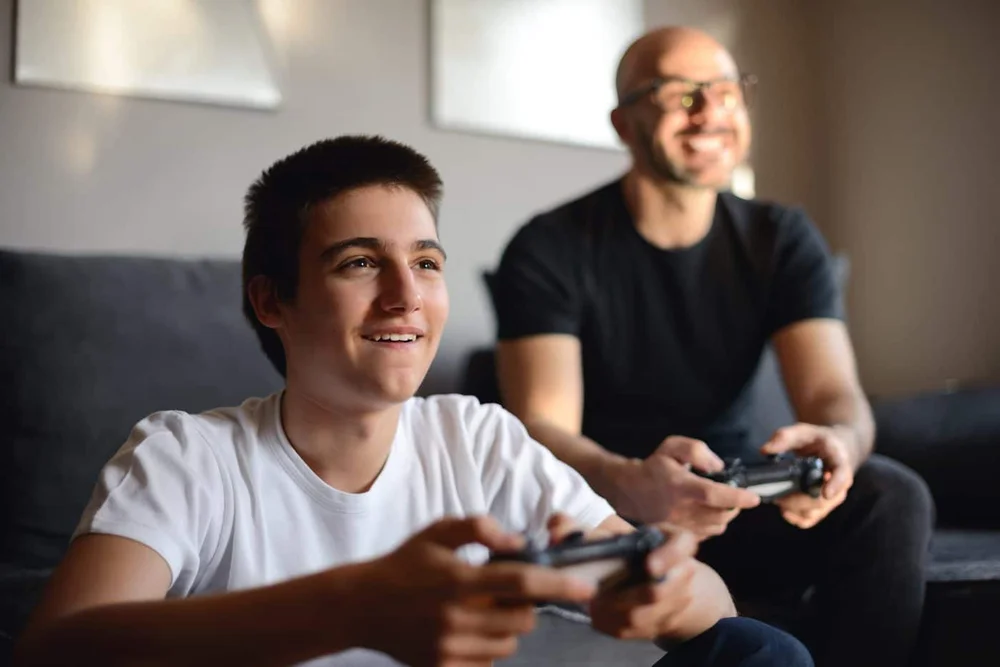The Best Ways to Protect Your Kid’s Eyesight
Decades ago, parents cautioned their kids to sit at least ten feet away from the family television set. Today, kids of all ages spend hours a day staring at computer screens or portable devices that are only a few inches away from their faces. How times have changed.
Dangers of Excessive Screen Time
Ongoing research reveals that concerns over kids and screens are justified. According to Common Sense Media, children under age 8 spend an average of two hours a day looking at a screen. Kids 8-10 years old are averaging around six hours a day staring at screens. That same research found that mobile media time has tripled from 2011-2017 among 0- to 8-year-olds.
Though parents tend to focus on the behavioral and psychological dangers of screen obsession, it’s possible for them to overlook the actual physical damage that can occur when their kids stare at illuminated screens for hours on end. These physical complications may include poor posture, neck strain, exposure to blue light and nearsightedness. Whether using their cell phone, tablet, or laptop to play video games, interact on social media, or study for school assignments, kids today are being set up for a host of eye problems.
Keeping an Eye on Vision Problems
Prolonged screen sessions can create many eye-related issues including tired or dry eyes, blurred vision, and headaches. Spending too much time looking at screens also can cause digital eye strain. Some refer to this as computer vision syndrome, a condition where extended screen time can cause visual stress.
With our society’s ever-increasing dependence on technology, what can you do to protect your child’s eyes from the harmful effects of excessive screen time? Following these 5 simple tips can help reduce the adverse effects of digital eye strain…
5 Ways to Protect Your Child’s Vision from Harmful Screens
1. Take a Break
Research demonstrates that taking breaks actually improves focus and efficiency. It also decreases the symptoms of digital eye strain. Train your child to practice the “20-20-20 Rule.”
Every 20 minutes, have them take their eyes off the screen and look at something that’s at least 20 feet away for at least 20 seconds. This simple exercise can help realign eye muscles and reduce eye strain. Also, by switching their attention to something else for a brief period, they can return to their original task with renewed focus.
2. Blue Light Protection
Due to the known potential of blue light to damage the retina of the eye and disrupt the body’s natural 24-hour circadian rhythm, awareness of its dangers, such as its relatively high intensity from LED screens, has increased over the past few years. It’s prudent to protect your child’s eyes from blue light, both from sunlight and digital devices.
Polarized sunglasses can cut down on glare and blue light when your child is outside. For indoor wear, one suggested option is eyeglasses with a blue light filter in the lenses. As a precaution, make sure the tint doesn’t bother your child’s eyes before investing in blue light reduction lenses.
3. Tuck in Your Tech
More and more, parents are limiting their kids’ TV or tablet time. Establish a time when all devices will be turned off for the remainder of the evening.
Not only will this provide a break from calling, texting, browsing the internet and posting content on social media, it will also afford your family the opportunity to spend more quality time together. Additionally, it will give your kids’ eyes a well-earned rest after a long day of looking at screens.
4. Eye Exams
When laying out your calendar, be sure to schedule annual eye exams for your kids. However, if at any time your child starts squinting or complaining about unfocused vision, headaches or other eye-related discomforts, make an appointment to see an optometrist as soon as possible. When it comes to your child’s eyesight, it’s always best to be proactive.
5. Nutritional Support
Due to the dramatic amount of growth and development they experience, children need an ongoing generous daily allowance of vitamins and minerals. These nutrients are scientifically proven essential for our cells to work, and are critical for children’s healthy growth, energy, vision, bone development, attention, learning, memory, and behavior. Failure to get enough of these nutrients leads to serious health problems, regardless of the child’s age or stage of development.
A great way to help your kids get the nutrients they need is with high-quality dietary supplements. At BrainMD, we offer a wide array of brain directed nutraceutical ingredients in supplements designed to assist kids in reaching their fullest potential. Two of these nutrients – lutein and zeaxanthin – are essential for coping with blue light and other vision stressors.
Lutein and Zeaxanthin
Lutein and zeaxanthin are essential for vision and eye health. They are are carotenoid nutrients that are highly concentrated in the eyes and some zones of the brain. They’re actively accumulated by the brain, and clinical findings suggest they are involved in memory and likely other cognitive brain functions.
Lutein and zeaxanthin are the yellow-orange pigments of the retina, needed for the retina’s electrical activity that translates into vision. They also protect the light-sensing cells of the retina against light damage – extremely important because light coming into the eye carries high energy that can kill these cells. They are also essential for efficient glare discrimination.
Lutein and zeaxanthin are practically vitamins, since the body can’t make them and we must get them from our diet. They are mostly present in leafy-green and yellow-red vegetables; surveys indicate many people aren’t getting enough of these nutrients from their foods. Sadly, very few multiples provide lutein and zeaxanthin.
To ensure your kids get the eye-strengthening support they need daily, consider having them take the multivitamin that has generous amounts of lutein and zeaxanthin…
Kids’ NeuroVite Orange Chewables
BrainMD’s Kids’ NeuroVite Orange Chewables was designed to bridge the nutrition gap in the modern diet and remove the guesswork from which multiple vitamin-mineral supplement is best for your children. Kids’ NeuroVite provides the vitamins and minerals that are needed for healthy minds and active bodies.
With our intense on purity, optimal absorption, and utilization, we selected the nutrient ingredients best documented for kids’ safety and overall health. This science-based formulation provides generous amounts of nutrients to support brain and body maturation during your child’s formative years.
Kids’ NeuroVite provides ultra-pure, brain directed ingredients that help:
- make energy (magnesium, the B vitamins, iodine)
- process sugars from the diet (chromium, B vitamins)
- ensure the brain’s maturation (methylfolate, methyl-vitamin B12, vitamin D, choline)
- promote healthy immunity (the B vitamins, vitamin C, zinc, selenium)
- protect against toxins (vitamins A, C and E, zinc, copper, manganese, molybdenum, hesperidin)
- support the electrical activity of the retina and the brain (lutein, zeaxanthin)
- provide a foundation for bones, skin and other organs (vitamins D and K, calcium, silicon, boron)
Kids’ NeuroVite surpasses other conventional brands in both the quality and quantity of its ingredients. Kids’ NeuroVite has nearly 3 times more ingredients than the average kids’ vitamin. Its diverse set of over 50 nutrients makes it the best multiple vitamin-mineral supplement to keep kids healthy and give you peace of mind.
Your child will love the taste of the orange-flavored chewables, which are free from sugar, dairy, gluten, corn, eggs, soy, nuts, and artificial colorings or flavorings.
Implementing these tips can help protect your child’s eyesight so they can have 20/20 vision in 2020 and beyond.
At BrainMD, we’re dedicated to providing the highest purity nutrients to give your children the energy, focus and mental sharpness they need to succeed in school and in life. For more information about our full list of supplements, please visit us at BrainMD.
- This Is What You Need to Know About HBOT
Medically Reviewed by Dr. Nicole Avena - April 22, 2024 - Hormone Changes in Men: How to Know If You Have Low Testosterone! - April 15, 2024
- This Is What You Need to Know About EMDR Therapy! - April 11, 2024



